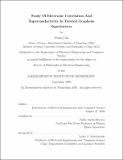| dc.contributor.advisor | Pablo Jarillo-Herrero. | en_US |
| dc.contributor.author | Cao, Yuan,Ph. D.Massachusetts Institute of Technology. | en_US |
| dc.contributor.other | Massachusetts Institute of Technology. Department of Electrical Engineering and Computer Science. | en_US |
| dc.date.accessioned | 2021-01-06T19:35:10Z | |
| dc.date.available | 2021-01-06T19:35:10Z | |
| dc.date.copyright | 2020 | en_US |
| dc.date.issued | 2020 | en_US |
| dc.identifier.uri | https://hdl.handle.net/1721.1/129246 | |
| dc.description | Thesis: Ph. D., Massachusetts Institute of Technology, Department of Electrical Engineering and Computer Science, September, 2020 | en_US |
| dc.description | Cataloged from student-submitted PDF of thesis. | en_US |
| dc.description | Includes bibliographical references (pages 151-164). | en_US |
| dc.description.abstract | Two-dimensional materials, such as graphene, exhibit various unique electronic and optical properties that distinguish them from their bulk parent compounds. Besides being highly tunable by electrostatic gating, these 2D materials can be assembled into van der Waals heterostructures, which greatly extend the possibilities one can achieve. Among these possibilities, the twist angle in a van der Waals heterostructure is a unique knob, which we can utilize to engineer the properties of the 2D materials in unprecedented ways. In this thesis, I mainly studied the electronic properties of twisted bilayer graphene, consisting of two pieces of graphene rotated by a certain angle. It is shown experimentally that the twist angle significantly alters the band structure, by reducing the Fermi velocity at the Dirac points and by inducing new band gaps, due to the formation of a moiré superlattice. In particular, at a 'magic' twist angle, the band structure becomes strongly flattened, to an extent that the Coulomb interactions between the electrons now become dominant. In such a regime, peculiar correlated insulator states and unconventional superconductivity are found, which share many common traits with those observed in high-T[subscript c] superconducting materials. These findings establish the first graphene superconductor in two dimensions. Furthermore, it is found that both the superconducting and normal state in magic-angle twisted bilayer graphene exhibit significant anisotropy, likely as a result of the electronic correlations as well. I also present results in twisted graphene superlattices beyond twisted bilayer graphene. These studies might help us understand more about the correlated physics in flat-band systems, which might in turn shed more light towards the research of high-T[subscript c] superconductors. | en_US |
| dc.description.statementofresponsibility | by Yuan Cao. | en_US |
| dc.format.extent | 164 pages | en_US |
| dc.language.iso | eng | en_US |
| dc.publisher | Massachusetts Institute of Technology | en_US |
| dc.rights | MIT theses may be protected by copyright. Please reuse MIT thesis content according to the MIT Libraries Permissions Policy, which is available through the URL provided. | en_US |
| dc.rights.uri | http://dspace.mit.edu/handle/1721.1/7582 | en_US |
| dc.subject | Electrical Engineering and Computer Science. | en_US |
| dc.title | Study Of electronic correlation and superconductivity in twisted graphene superlattices | en_US |
| dc.type | Thesis | en_US |
| dc.description.degree | Ph. D. | en_US |
| dc.contributor.department | Massachusetts Institute of Technology. Department of Electrical Engineering and Computer Science | en_US |
| dc.identifier.oclc | 1227516842 | en_US |
| dc.description.collection | Ph.D. Massachusetts Institute of Technology, Department of Electrical Engineering and Computer Science | en_US |
| dspace.imported | 2021-01-06T19:35:09Z | en_US |
| mit.thesis.degree | Doctoral | en_US |
| mit.thesis.department | EECS | en_US |
